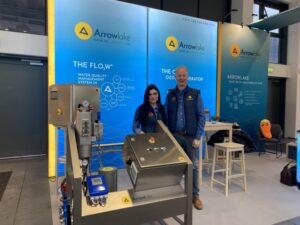Something in the water: Companies pioneer wash water innovation
When consumers purchase processed produce, such as bags of leafy greens, they expect it to be clean and safe to consume, and to have a reasonable shelf life.
Processors need to be able to deliver these products without using excessive amounts of water, and in some countries like The Netherlands, without the use of chemical disinfectants such as chlorine.

Two companies, Sormac and Arrowlake, showcased nonchemical innovations for wash water disinfection at Fruit Logistica 2023 in Berlin.
Sormac develops new UV-C Unit for wash lines
During the washing process of fresh fruits and vegetables, wash water becomes contaminated with microorganisms. To prevent multiplication and cross- contamination, wash water needs to be disinfected. While many processors rely on chemicals such as chlorine for sanitation, in the Netherlands, use of the chemical has been banned, leaving processors looking for alternative solutions.
To address this issue, Sormac investigated the use of UV-C technology to disinfect washing water. Marianne Knorr-Jansen, quality and research, led the pilot-scale study in Sormac’s in-house laboratory. She said that as long as UV-C, the shortest wavelength of three forms of UV, is used correctly, the technology offers a viable solution for wash water disinfection, targeting bacteria, bacterial spores, parasites and viruses.
Using UV for disinfection purposes is not new, especially in other sectors. But Knorr-Jansen said she and the team at Sormac weren’t sure it would be effective enough in dirty wash water.
Sormac’s research and development team first built a prototype and began testing bacterial load at various ‘doses,’ which varied based on contact time and UV intensity. They also tested to see how far UV light could reach, and whether it could be transmitted effectively in dirty water.
Sormac’s UV-C unit is an add-on for its washing machines. It disinfects washing water through homogeneous illumination of wash water. The UV intensity is measured by two sensors and regulated as needed. The lamps are covered with a protective sleeve, which prevents glass from entering the wash water should a breakage occur.
According to Knorr-Jansen, the unit offers three benefits for processors. It reduces the likelihood of cross- contamination. Because microbiologically cleaner product lasts longer, it extends product shelf life. Finally, it offers financial savings in terms of limiting fresh water use.
Sormac’s UV-C unit has been on the market for more than a year.
Ozone generator solution from Arrowlake
During the processing of fruits and vegetables, conditions can change throughout the day.
Bacterial load will fluctuate depending on a variety of factors, including weather conditions, the quality of raw product coming in, the people handling the product, and the equipment used to process it. This means the quality of process water will vary throughout the cycle as well.
Many processors look to chemicals such as chlorine to disinfect water. Some simply discharge the dirty water and replace it with fresh. The former solution is not available to all processors, and the latter comes at a hefty cost.
Camilla Khrulova, ozone application specialist and head of food and beverage at Arrowlake, along with Arrowlake colleague Jurgen Bischhaus, director of sales and marketing, developed a solution: an ozone generator, an all-in- one water quality management system called the FLO3W, specifically for the food processing sector.
Developing the ozone generator was no easy task, Khrulova said. The first challenge was how to keep the ozone in water long enough to do its job, as it tended to bubble to the surface.
“It took some years of research, but we have figured out a way to actually take any ozone produced by anyone and dissolve it and mix it in the water at very high concentrations,” Khrulova said.
The duo also figured out how to automatically generate enough ozone to treat the water no matter what condition it is in. To do this, FLO3W measures water parameters, including pH, temperature, dissolved ozone and redux, throughout the process.
Ozone is known as a good tool for degrading bacterial load. In fact, according to Khrulova, it is 3,000 times more powerful than chlorine. Furthermore, its only waste by-product is oxygen.
According to Khrulova, FLO3W allows processors to real-time monitor, control and analyze process water. Food processors are able to maintain microbiological water quality standards throughout the processing cycle while preventing the formation of biofilm in the long-term.
Using ozone lessens the need for mechanical and chemical cleaning, and it prevents cross-contamination and re-contamination of produce between temperature-controlled environments. In fresh produce like carrots, the result is increased product quality and longer shelf life.
Further benefits of utilizing ozone include the elimination of chemical residues on produce and less reliance on valuable resources such as energy and water.
A small carrot producer in the Netherlands, for instance, saves 50,000 kilowatts a year in energy and six cubic meters of water per day by installing this system, Khrulova said.
“And we’re not even talking about shelf life,” she said. “By retrofitting FLO3W, you are actually increasing the shelf life of your produce simply by releasing the product from all the cross- contamination that you have introduced to it by the process.”
Khrulova believes uptake of ozone will happen once processors realize the benefits.
“It’s a really useful tool that is not that complicated,” she said.







